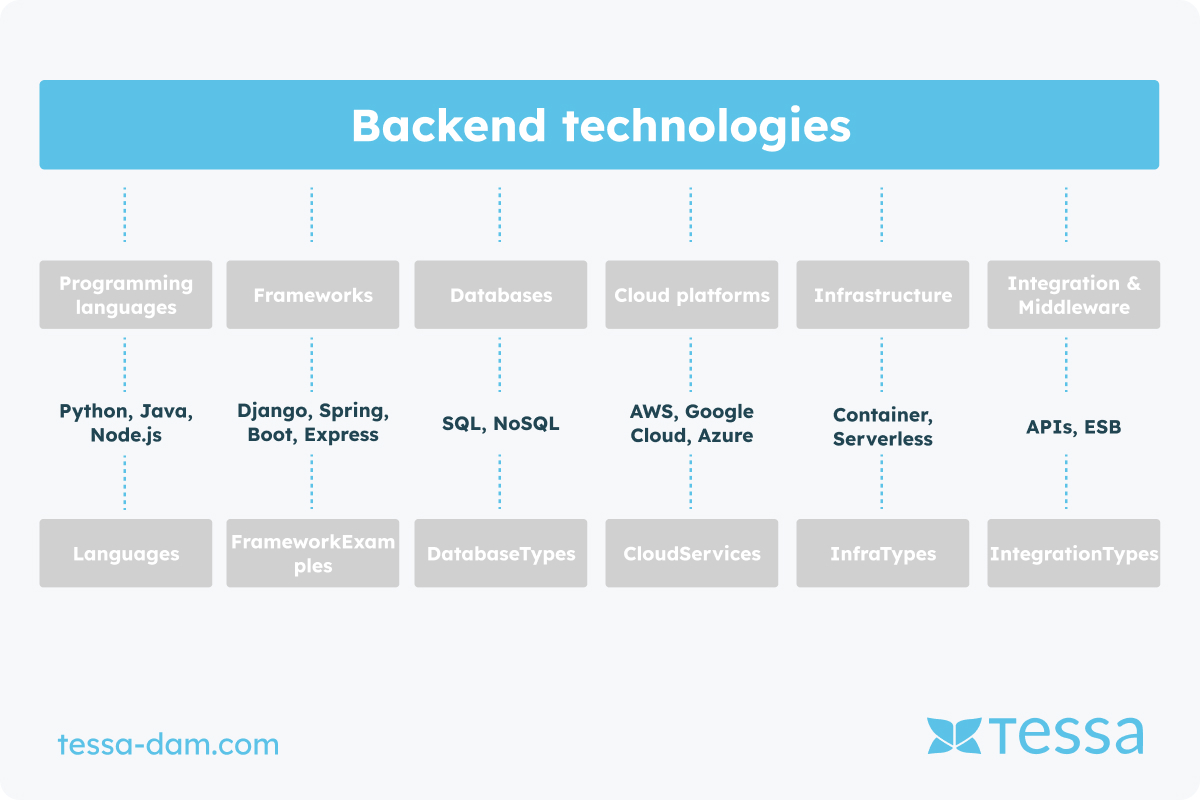What is a Backend?
In the digital era, efficient management of product information, content, and digital assets is crucial for business success. Backend systems play a central role in supporting these tasks through Product Information Management (PIM), Content Management Systems (CMS), and Digital Asset Management (DAM). These systems form the backbone of digital platforms by managing complex data structures, enabling integration of various information sources, and optimizing content delivery across multiple channels.
The backend, often operating in the background, enables companies to precisely organize their product information, effectively manage content, and systematically store and retrieve digital assets. These processes are fundamental to creating coherent user experiences, promoting brand consistency, accelerating business processes, and forming the basis for presenting data in the frontends, the visible level for users and customers.
In this post, we will delve deeper into the importance of backend systems for PIM, CMS, and DAM. We will examine the core components and architecture of these systems, discuss technological foundations and platforms, and shed light on challenges and solutions in data management and system integration. Through the exploration of features, use cases, and future trends, this post aims to provide a comprehensive understanding of the role of the backend in modern digital asset and content management.
With the evolution of the technology landscape and the increasing demands on digital platforms, the evolution of backend systems is inevitable. By considering current and future developments in this area, we provide an outlook on how companies can adjust their backend strategies to remain competitive in the digital age
What Key Components and Architecture Does a Backend Have?
The architecture of backend systems supporting Product Information Management (PIM), Content Management Systems (CMS), and Digital Asset Management (DAM) is complex and multi-layered. It comprises a set of components that collaborate to efficiently store, manage, and deliver data. At the core of these systems are databases, application servers, and various integration layers that enable seamless communication between internal and external systems.
Databases are the heart of every backend system. They store product information, content, and digital assets in a structured form, enabling fast access and efficient queries. Modern backend systems often use relational (SQL) databases, whose instantiation depends on specific requirements for scalability, flexibility, and performance.
Application servers play a crucial role by processing the business logic necessary to serve requests from frontend applications (such as websites and mobile apps). They handle functions such as user authentication, processing business transactions, and integration with other systems such as ERP (Enterprise Resource Planning) or CRM (Customer Relationship Management).
Integration layers are responsible for connecting the backend to other systems and services. They facilitate the exchange of data between PIM, CMS, DAM, and external systems, support workflow automation, and promote data consistency across various platforms. REST APIs (Application Programming Interfaces) and middleware solutions are common technologies used in these layers to enable flexible and scalable integrations.
The architecture of backend systems can vary significantly depending on the specific needs of a company. Some organizations prefer monolithic architectures, where all components are tightly integrated, while others opt for microservices architectures that allow for decomposition into smaller, independently manageable services. Cloud-based solutions and serverless architectures are also gaining popularity for their high flexibility, scalability, and cost-effectiveness.
Regardless of the specific configuration, the architecture of backend systems is crucial for the performance and effectiveness of PIM, CMS, and DAM. It must be carefully planned and regularly reviewed to ensure it meets the changing requirements of the company and its digital strategy. For effective operation with a DAM, the connection to a CDN – Content Delivery Network is becoming increasingly relevant.
What Technological Foundations and Platforms Does a Backend Have?
The selection of technologies and platforms forms the foundation for powerful backend systems in the realm of Product Information Management (PIM), Content Management Systems (CMS), and Digital Asset Management (DAM). These decisions significantly influence the flexibility, scalability, and security of the systems, as well as their ability to integrate with other services and applications. The following presents the key technologies and platforms used in modern backend systems for PIM, CMS, and DAM.
Programming Languages and Frameworks
The choice of programming language and its associated framework is crucial for the development of backend systems. Popular languages such as Python, Java, and JavaScript (Node.js) offer robust frameworks and libraries that accelerate development and promote best practices. Symfony provides an excellent foundation for stable integrated development.
Database Technologies
The choice of database technology depends on the specific requirements of the project. Relational databases like PostgreSQL and MySQL are ideal for applications requiring complex queries and transactions with strict consistency requirements. Non-relational databases, or NoSQL databases (such as MongoDB and Cassandra), offer flexibility in data structure and scalability, making them attractive for applications with large amounts of unstructured data or high write and read loads.
Cloud Platforms and Infrastructure
Cloud-based solutions like AWS (Amazon Web Services), Google Cloud Platform, and Microsoft Azure offer a wide range of services and tools for the development, deployment, and scaling of backend systems. These platforms support both traditional and serverless architectures, provide managed database services, and enable flexible scaling of resources as needed. Leveraging cloud infrastructure can shorten development time and enable companies to focus on the core functions of their applications rather than managing the underlying hardware.
Integration und Middleware
The ability to integrate various systems and applications is crucial for PIM, CMS, and DAM. Middleware solutions and API gateways facilitate communication between different services, both internally and with external partners. REST APIs and GraphQL are popular approaches for developing interfaces that enable efficient and flexible data querying and manipulation.
The selection of the right technologies and platforms is an ongoing process that requires careful consideration of the system's current and future requirements. Companies must monitor trends and developments in the technology landscape to ensure their backend systems remain innovative and meet the changing needs of their users.
What Architectural Patterns Exist in the Backend?
The architecture of the backend plays a crucial role in the development and operation of software applications, including systems for Product Information Management (PIM), Content Management (CMS), and Digital Asset Management (DAM). The choice of architectural pattern directly affects the performance, scalability, maintainability, and the system's ability to respond to future requirements. In this section, we describe the most common architectural patterns in the backend and their respective advantages and disadvantages.
Monolithic Architecture
In a monolithic architecture, all application components are integrated into a single, indivisible software block. This pattern has long been the standard in software development, as it enables simple deployment and development. However, the size and complexity of a monolith can quickly grow, making maintenance and scaling challenging.
Advantages: Simplicity in development and deployment, as everything is in a single codebase.
Disadvantages: Poor scalability, as small changes require redeployment of the entire application; difficulties in maintenance and updating.
Microservices Architecture
The microservices architecture consists of a collection of small, autonomous services that communicate via well-defined APIs. Each microservice is responsible for a specific area and can be developed, deployed, and scaled independently of other services.
Advantages: Increased flexibility and scalability, as services can be scaled and updated independently; promotion of technological diversity.
Disadvantages: Complexity in managing and orchestrating services; challenges in data consistency across services.
Serverless Architectures
Serverless architectures allow developers to build and operate applications and services without having to manage the underlying servers. Cloud platform providers handle the scaling, maintenance, and security of the infrastructure.
Advantages: High scalability and cost-efficiency, as resources are dynamically allocated and billed only for actual usage; reduced overhead in server management.
Disadvantages: Limitations in terms of runtime environment and cold start times; potential challenges in monitoring and debugging.
Containerization and Orchestration
Containerization allows packaging applications and their dependencies into lightweight, portable containers. Tools like Kubernetes provide orchestration capabilities that automate the deployment, scaling, and operation of containerized applications.
Advantages: Consistency across development, testing, and production environments; improved portability and scalability.
Disadvantages: Complexity in setting up and managing orchestration tools; learning curve for teams unfamiliar with containerization technologies.
How Does Data Management and Integration Work via Backend?
In the world of Product Information Management Systems (PIM), Content Management Systems (CMS), and Digital Asset Management Systems (DAM), efficient management and seamless integration of data are crucial for success. These systems must not only store and process large amounts of data but also ensure that this data is consistent and up-to-date across various platforms and channels. This section sheds light on the challenges, strategies, and solutions related to data management and integration.
Strategies for Effective Data Management
A robust data management strategy begins with defining clear data models that establish the structure, relationships, and validation rules for the stored information. This is especially important in PIM systems, where product information often comes from a variety of sources and complex relationships exist between products, categories, variants, and attributes. Effective data modeling ensures data integrity and reusability and facilitates maintenance.
Furthermore, implementing data quality measures, such as automatic data validation upon input and regular data checks for completeness and accuracy, is crucial. For CMS and DAM, managing metadata – information about the content and digital assets – is essential to enable efficient search, reuse, and archiving.
Challenges and Solutions in Integration
Integrating PIM, CMS, and DAM systems into an organization's existing IT landscape can pose complex challenges. These range from overcoming technical incompatibilities to synchronizing data across system boundaries. Using standardized interfaces and protocols, such as REST APIs and SOAP, facilitates the integration of external systems and services.
Another approach to overcoming integration challenges is the use of middleware and Enterprise Service Bus (ESB) technologies, which act as intermediary layers between different systems. These technologies support the transformation and routing of messages, enabling flexible and scalable integration.
Additionally, data warehousing and ETL (Extract, Transform, Load) processes play an important role in consolidating data from various sources. They enable centralized analysis and reporting, which is essential for strategic decision-making.
Best Practices for Successful Integration
To ensure successful integration, companies should start with thorough planning that considers both the technical requirements and business goals. Early involvement of all stakeholders, including IT personnel, data analysts, and end-users, is crucial to define requirements clearly and promote solution acceptance.
An iterative implementation, where integration steps are performed and tested incrementally, can minimize risks and ensure that issues are identified and addressed early on. Furthermore, continuous monitoring and adjustment of integration processes are necessary to respond to changes in the IT landscape or business requirements.





